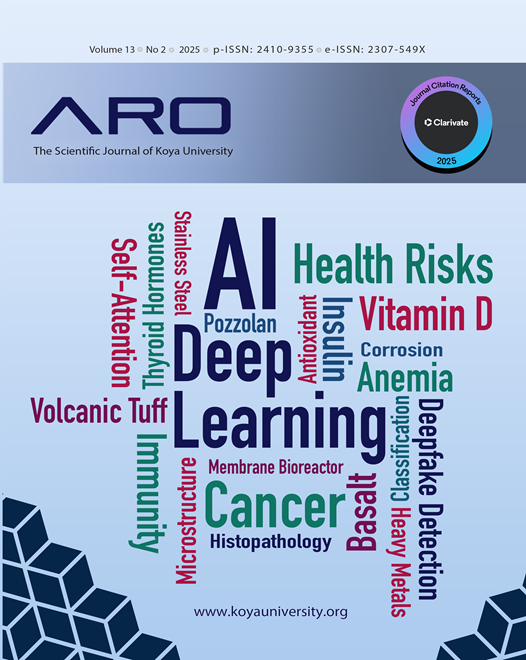Durability Assessment of Green Concrete Incorporating Volcanic Tuff Pozzolan, Basalt, and Recycled Aggregate
DOI:
https://doi.org/10.14500/aro.12083Keywords:
Basalt, Durability, Green concrete, Recycled gravel, Resistance to simple pressure, Volcanic tuffAbstract
Extending the lifespan of building structures is a critical strategy for mitigating environmental impacts, particularly greenhouse gas emissions from cement production, like emissions from cement. Green concrete, made from pozzolana, basalt, and recycled materials, was tested for durability. Samples were immersed in 2% sulfuric acid for a week, then checked for resistance loss. This study investigates the performance of various concrete mixtures through experiments and simulations where Portland Cement was replaced
by natural pozzolana ground into the bonding paste in proportions ranging from 10% to 50% with the use of four types of gravel structures I (natural gravel), II (recycled gravel), III (pozzolanic gravel with basalt sand), and IV (pozzolanic gravel and sand), where 128 cubes were poured with dimensions (10 × 10 × 10) cm to perform simple pressure tests on samples before and after immersion in a solution of sulfuric acid. The results showed that higher cement replacement percentages in mixtures with recycled aggregates resulted in greater durability reduction, with resistance losses exceeding 34% at 50% replacement, primarily due to the rounded aggregate morphology and lower acid resistance. In contrast, mixtures incorporating pozzolanic gravel and basalt sand showed superior performance, achieving only 18.7% resistance loss at 50% replacement (compared to 30.1% at lower replacement rates), highlighting basalt’s effective pore-filling capability. The optimal performance was observed in pozzolanic gravel-sand blends, which exhibited just 13.7% resistance loss, demonstrating enhanced synergistic pozzolanic activity. These findings validate that optimized pozzolana-basalt combinations significantly improve chemical resistance, offering promising solutions for sustainable concrete development.
Downloads
References
ACI Code., 2019. 318-19; Building Code Requirements for Structural Concrete and Commentary. Farmington Hills, MI, USA, American Concrete Institute.
AL‐Ameeri, A.S., Imran Rafiq, M., Tsioulou, O., and Rybdylova., O., 2022. Modelling chloride ingress into in‐service cracked reinforced concrete structures exposed to de-icing salt environment and climate change: Part 1. Structural Control and Health Monitoring, 29, p.e3032. DOI: https://doi.org/10.1002/stc.3032
Alghamdi, H., 2022. A review of cementitious alternatives within the development of environmental sustainability associated with cement replacement. Environmental Science and Pollution Research, 29, p. 42433-42451. DOI: https://doi.org/10.1007/s11356-022-19893-6
Al-swaidani, A.M., 2021. Natural pozzolana of micro and nano-size as cementitious additive: Resistance of concrete/mortar to chloride and acid attack. Cogent Engineering, 8, p.1996306. DOI: https://doi.org/10.1080/23311916.2021.1996306
Beddoe, R.E., and Dorner, H.W., 2005. Modelling acid attack on concrete: Part I. The essential mechanisms. Cement and Concrete Research, 35, pp.2333-2339. DOI: https://doi.org/10.1016/j.cemconres.2005.04.002
Bizzozero, J., Gosselin, C., and Scrivener, K.L., 2014. Expansion mechanisms in calcium aluminate and sulfoaluminate systems with calcium sulfate. Cement and Concrete Research, 56, pp.190-202. DOI: https://doi.org/10.1016/j.cemconres.2013.11.011
Chemrouk, M., 2015. The deteriorations of reinforced concrete and the option of high performances reinforced concrete. Procedia Engineering, 125, pp.713-724. DOI: https://doi.org/10.1016/j.proeng.2015.11.112
Chen, X., Wu, X., Bian, X., Wu, Q., Cheng, S., and Ren, C., 2024. Evaluating the physicochemical properties of pervious recycled aggregate concrete incorporating pozzolanic additives under acid rain attack. Construction and Building Materials, 411, p.134507. DOI: https://doi.org/10.1016/j.conbuildmat.2023.134507
Ekolu, S.O., Hooton, R.D., and Thomas, M.D.A., 2006. Studies on Ugandan volcanic ash and tuff. In: Mwakali, J.A., and Taban-Wani, G. Eds. Proceedings from the International Conference on Advances in Engineering and Technology. Oxford, Elsevier Science Ltd. DOI: https://doi.org/10.1016/B978-008045312-5/50009-1
Habert, G, Miller, S.A., John, V.M., Provis, J.L., Favier, A., Horvath, A., and Scrivener, K.L., 2020. Environmental impacts and decarbonization strategies in the cement and concrete industries. Nature Reviews Earth and Environment, 1, pp.559-573. DOI: https://doi.org/10.1038/s43017-020-0093-3
Kanaan, D., Soliman, A.M., and Suleiman, A.R., 2022. Zero-cement concrete resistance to external sulfate attack: A critical review and future needs. Sustainability, 14, p.2078. DOI: https://doi.org/10.3390/su14042078
Kerkhoff, B., 2007. Effects of Substances on Concrete and Guide to Protective Treatments (Portland Cement Association Skokie, IL). United States, Portland Cement Association Skokie.
Kheirbek, A., and Aljubayli, N., 2014. Study the influence of replacement the aggregates of mortar with natural pozzolana on its fresh and hardened properties. Tishreen University Journal for Scientific Research and Studies Engineering Sciences Series, 36, pp. 145-157.
Kheirbek, A., Saoud, L., and Ibrahim, G.A., 2022. Astudy of the effect of adding syrian natural pozzolana on the resistance of concrete to acidic media. Al-Baath University Journal, 44(12), pp. 11-30.
Li, C., Li, J., Ren, Q., Zheng, Q., and Jiang, Z., 2023. Durability of concrete coupled with life cycle assessment: Review and perspective. Cement and Concrete Composites, 139, p.105041. DOI: https://doi.org/10.1016/j.cemconcomp.2023.105041
Miller, S.A., Horvath, A., and Monteiro, P.J.M., 2018. Impacts of booming concrete production on water resources worldwide. Nature Sustainability, 1, pp.69-76. DOI: https://doi.org/10.1038/s41893-017-0009-5
Miller, S.A., John, V.M., Pacca, S.A., and Horvath, A., 2018. Carbon dioxide reduction potential in the global cement industry by 2050. Cement and Concrete Research, 114, pp.115-124. DOI: https://doi.org/10.1016/j.cemconres.2017.08.026
Ministry of Housing and Urban-Rural Development of the People’s Republic of China., 2019. Standard for Design of Concrete Structure Durability. Beijing, China, Hina Architecture Publishing and Media Co., Ltd.
Monteiro, P.J.M., Miller, S.A., and Horvath, A., 2017. Towards sustainable concrete. Nature Materials, 16, pp.698-699. DOI: https://doi.org/10.1038/nmat4930
Ponzi, G.G.D., Santos, V.H.J.M., Martel, R.B., Pontin, D., Stepanha, A.S.G., Schütz, M.K., Menezes, S.C., Einloft, S.M.O., and Vecchia, F.D., 2021. Basalt powder as a supplementary cementitious material in cement paste for CCS wells: Chemical and mechanical resistance of cement formulations for CO2 geological storage sites. International Journal of Greenhouse Gas Control, 109, p.103337. DOI: https://doi.org/10.1016/j.ijggc.2021.103337
Safiuddin, MD., 2017. Concrete damage in field conditions and protective sealer and coating systems. Coatings, 7, p.90. DOI: https://doi.org/10.3390/coatings7070090
Sivakrishna, A, Adesina, A., Awoyera, P.O., and Kumar, K.R., 2020. Green concrete: A review of recent developments. Materials Today Proceedings, 27, pp.54-58. DOI: https://doi.org/10.1016/j.matpr.2019.08.202
Tam, Vivian, W.Y., Soomro, M. and Evangelista, A.C.J. 2018. A review of recycled aggregate in concrete applications (2000–2017). Construction and Building Materials, 172, pp. 272292. DOI: https://doi.org/10.1016/j.conbuildmat.2018.03.240
The British Standards Institution., 2014. Concrete-Specification, Performance, Production and Conformity, BSI Standard Limited. London, UK, The British Standards Institution.
Wassouf, M., Omran, J., and Kheirbek, A., 2024. Effect of natural pozzolana, pozzolanic sand, and basalt on thermal and mechanical properties of green concrete. Building Engineering, 3, p.1739. DOI: https://doi.org/10.59400/be1739
Whittaker, M., and Black, L., 2015. Current knowledge of external sulfate attack. Advances in Cement Research, 27, pp.532-545. DOI: https://doi.org/10.1680/jadcr.14.00089
Xing, W., Tam, V.W.Y., Le, K.N., Hao, J.L., and Wang, J., 2023. Life cycle assessment of sustainable concrete with recycled aggregate and supplementary cementitious materials. Resources Conservation and Recycling, 193. p.106947. DOI: https://doi.org/10.1016/j.resconrec.2023.106947
Yi, Y., Zhu, D., Guo, S., Zhang, Z., and Shi, C., 2020. A review on the deterioration and approaches to enhance the durability of concrete in the marine environment. Cement and Concrete Composites, 113, p.103695. DOI: https://doi.org/10.1016/j.cemconcomp.2020.103695
Zhao, H., Hu, Y., Tang, Z., Wang, K., Li, Y., and Li, W., 2022. Deterioration of concrete under coupled aggressive actions associated with load, temperature and chemical attacks: A comprehensive review. Construction and Building Materials, 322, p.126466. DOI: https://doi.org/10.1016/j.conbuildmat.2022.126466
Zheng, Y., Zhang, Y., Zhuo, J., Zhang, Y., and Wan, C., 2022. A review of the mechanical properties and durability of basalt fiber-reinforced concrete. Construction and Building Materials, 359, p.129360. DOI: https://doi.org/10.1016/j.conbuildmat.2022.129360
Downloads
Published
How to Cite
Issue
Section
License
Copyright (c) 2025 Moustafa A. Wassouf, Jamal Y. Omran, Ali I. Kheirbek

This work is licensed under a Creative Commons Attribution-NonCommercial-ShareAlike 4.0 International License.
Authors who choose to publish their work with Aro agree to the following terms:
-
Authors retain the copyright to their work and grant the journal the right of first publication. The work is simultaneously licensed under a Creative Commons Attribution License [CC BY-NC-SA 4.0]. This license allows others to share the work with an acknowledgement of the work's authorship and initial publication in this journal.
-
Authors have the freedom to enter into separate agreements for the non-exclusive distribution of the journal's published version of the work. This includes options such as posting it to an institutional repository or publishing it in a book, as long as proper acknowledgement is given to its initial publication in this journal.
-
Authors are encouraged to share and post their work online, including in institutional repositories or on their personal websites, both prior to and during the submission process. This practice can lead to productive exchanges and increase the visibility and citation of the published work.
By agreeing to these terms, authors acknowledge the importance of open access and the benefits it brings to the scholarly community.
Accepted 2025-07-04
Published 2025-08-01
















 ARO Journal is a scientific, peer-reviewed, periodical, and diamond OAJ that has no APC or ASC.
ARO Journal is a scientific, peer-reviewed, periodical, and diamond OAJ that has no APC or ASC.